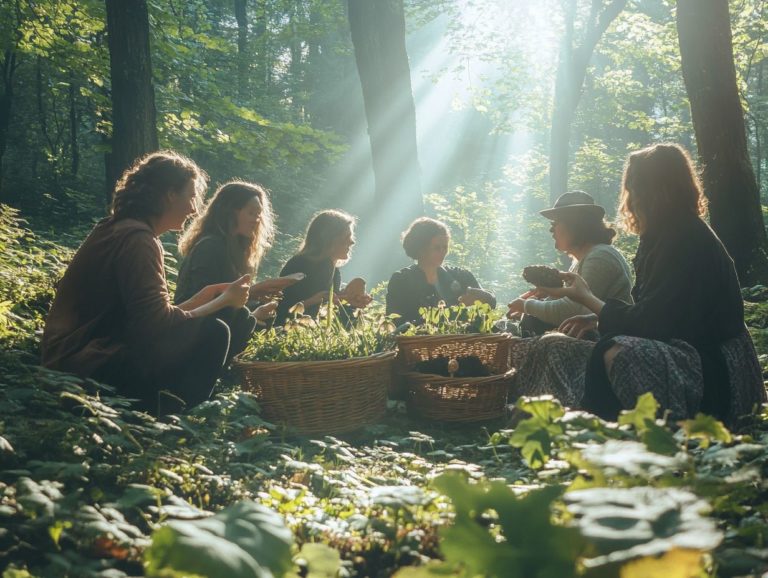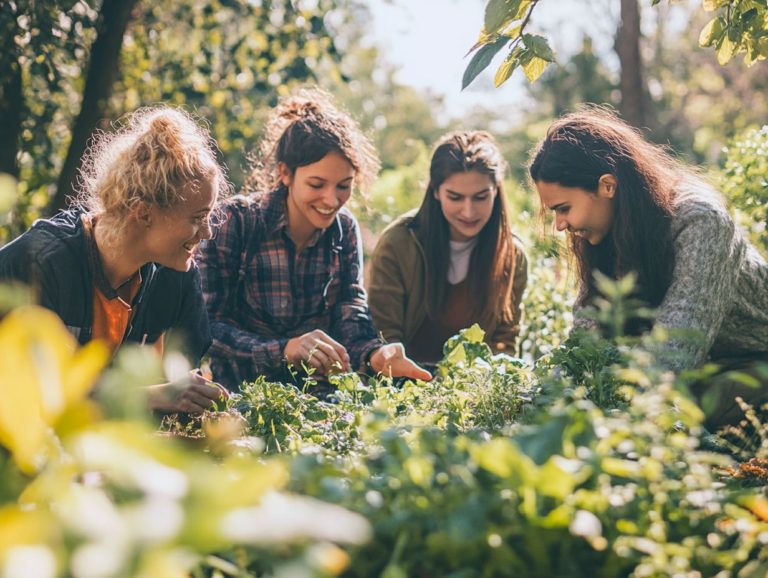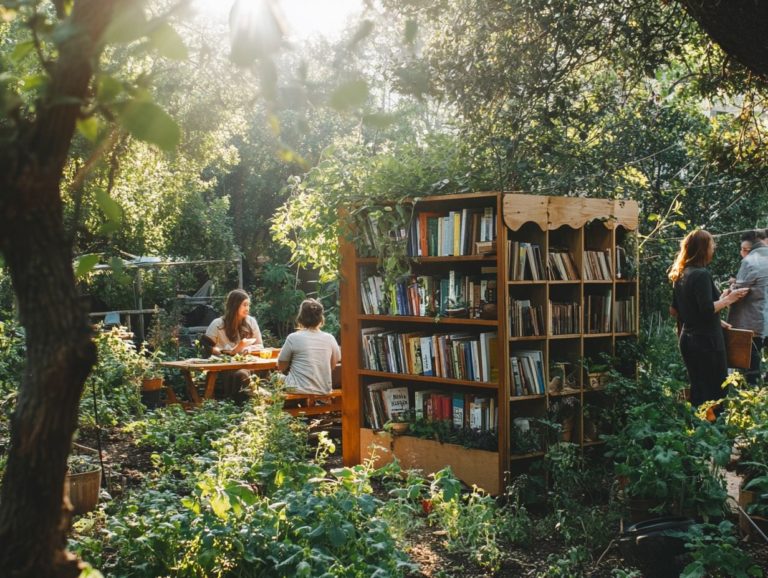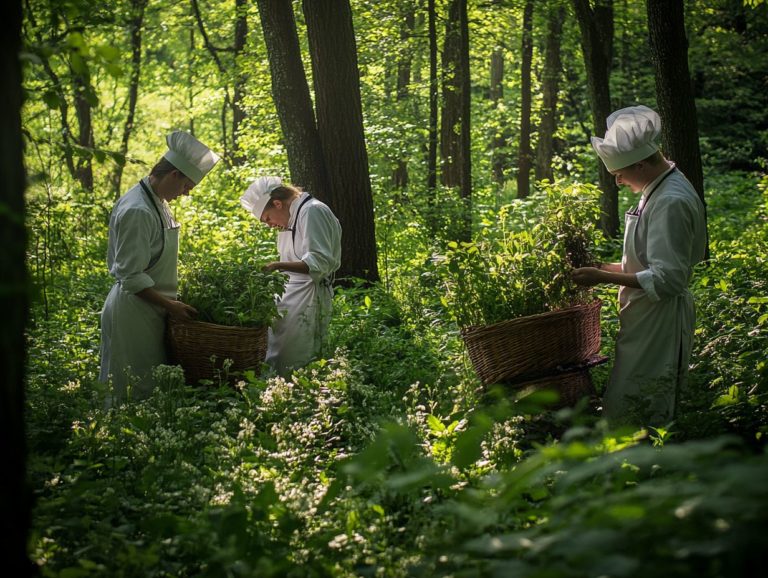How to Cultivate a Love for Foraging Locally
Foraging locally offers more than just a charming way to engage with nature; it presents a wealth of health benefits and environmental advantages as well.
This guide will illuminate local regulations, help you identify edible plants and fungi, and provide essential tips to embark on your foraging journey.
Whether you seek to introduce unique flavors into your cooking variety or reduce your ecological footprint, you ll uncover practical insights, safety guidance, and delectable recipes to elevate your foraging experiences.
Dive in now and discover the thrilling world of wild harvesting!
Contents
Key Takeaways:

- Discover the health and environmental benefits of foraging locally, including increased physical activity and reduced carbon footprint.
- Know your local laws before heading out for foraging. Bring the right tools.
- Learn to identify safe and edible plants and fungi. Practice foraging safety by taking precautions and following tips for a successful and enjoyable experience.
The Benefits of Foraging Locally
Foraging locally presents a wealth of benefits that go far beyond just enhancing your cooking skills; it enriches your personal health, strengthens community ties, and promotes environmental sustainability. If you’re interested in exploring this further, check out how to start foraging as a hobby.
By immersing yourself in the practice of foraging, you can forge a profound connection with your natural surroundings and deepen your appreciation for wild plants. Learning how to develop your own foraging techniques can enhance this experience with edible herbs.
This overall approach doesn t just elevate your diet with the nutritional advantages of fresh, wild foods; it also supports local ecosystems by encouraging sustainable harvesting techniques methods that allow you to collect plants without harming the environment and fostering ecological respect.
Engaging in foraging within community groups helps you build relationships, exchange knowledge, and cultivate a sense of belonging among others who share your passion for preserving nature.
Health and Environmental Benefits
The health and environmental benefits of foraging are truly remarkable, granting you access to nutrient-rich wild foods while enhancing your ecological awareness.
By weaving foraging into your lifestyle, you may find joy in sourcing fresh ingredients directly from nature, significantly increasing the variety of nutrients in your diet. To enhance this experience, consider learning how to promote foraging in your community. This practice not only contributes to your physical well-being by incorporating vitamins and minerals found in wild plants but also fosters a deeper connection to the environment.
As you learn to identify and gather local flora, you’ll likely develop a profound respect for biodiversity, leading to more sustainable choices and nurturing habitats that thrive with minimal human impact. Additionally, understanding how to encourage others to try foraging can help foster this beautiful balance with nature that enriches your life.
Getting Started with Foraging
Embarking on the foraging journey is an exhilarating and fulfilling experience, bolstered by a wealth of educational resources and community support designed to guide you every step of the way.
Whether you re enrolling in herbal courses, participating in foraging workshops, or tapping into local expertise, you ll find that the process of safely identifying edible plants and grasping their roles within our ecosystem is both captivating and illuminating.
By arming yourself with essential knowledge and the right foraging tools, you ll not only elevate your culinary adventures but also cultivate a profound connection to nature and a heightened awareness of outdoor safety.
Understanding Local Laws and Regulations
Understanding local laws and regulations regarding foraging is essential for ensuring compliance and promoting sustainable practices within your community.
By following local no-picking rules, you protect native plants and safeguard ecosystems from potential harm. Be mindful of food safety guidelines, which include properly identifying edible species and steering clear of contaminated areas, ensuring the food you collect is safe for consumption.
Recognizing and reporting invasive species is crucial as they threaten local wildlife and disrupt habitats. Encouraging respect for these regulations fosters a culture of responsible foraging, allowing future generations to explore and enjoy the abundant natural resources in their environment.
Essential Tools and Equipment
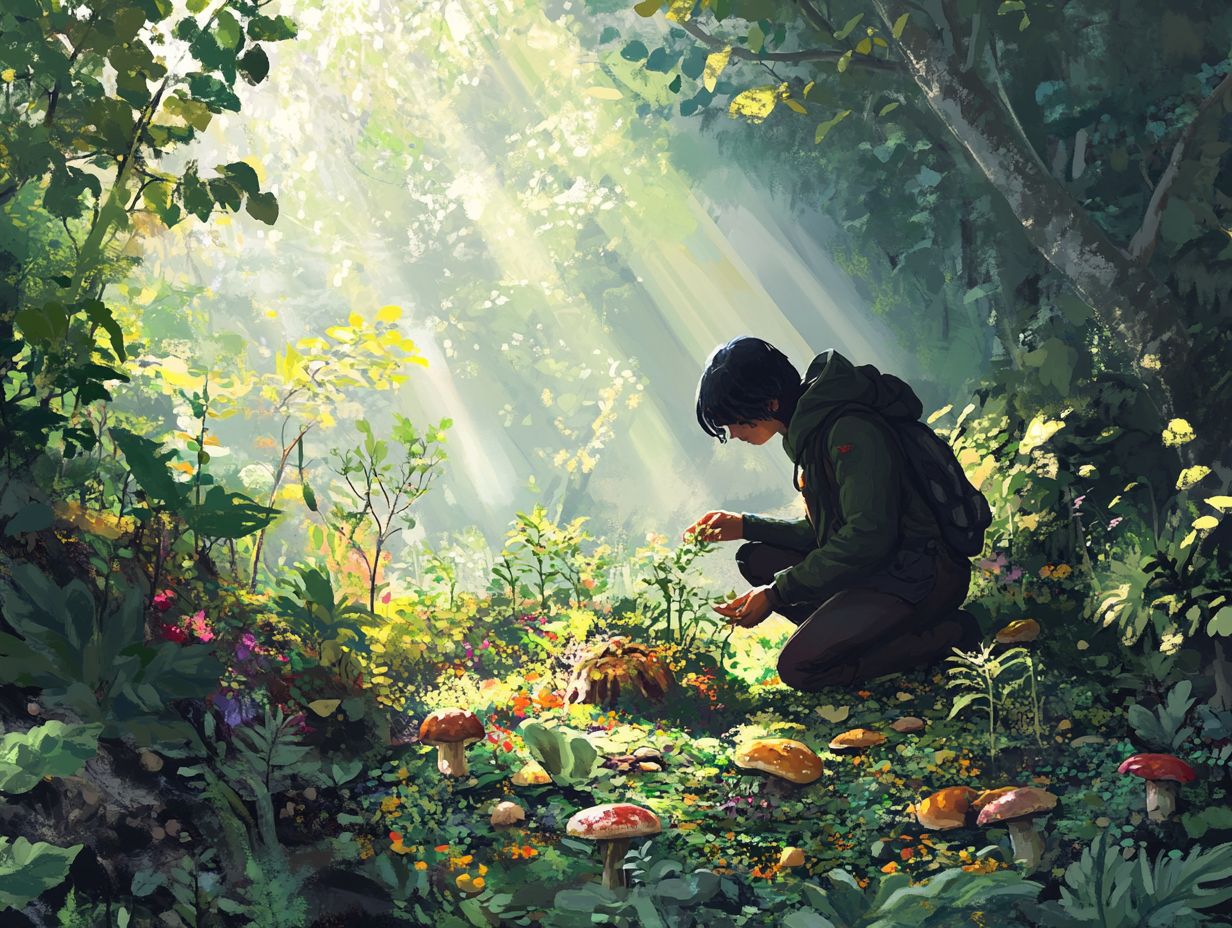
Having the right tools and equipment is crucial for a rewarding foraging experience, significantly enhancing your safety and efficiency in finding wild food resources.
Sturdy baskets are an absolute must for collecting edible plants and mushrooms. They facilitate air circulation, helping keep your foraged treasures fresh and vibrant. A reliable knife is equally essential, allowing you to harvest plant matter cleanly and with minimal impact on the surrounding ecosystem.
Always carry a well-stocked first aid kit to ensure you re prepared for anything! This helps you swiftly handle minor mishaps like scrapes or insect bites. Understanding effective harvesting methods like cutting plants at their base or gently twisting mushrooms from their substrate promotes sustainability, meaning taking care of natural resources for future generations.
Identifying Edible Plants and Fungi
Identifying edible plants and fungi is the exciting heart of foraging! It demands both knowledge and practice to successfully navigate the wild landscape. As you embark on your wild food adventures, cultivating a sharp understanding of plant identification becomes essential.
Learning to recognize commonly found species like dandelion, violets, wild mustard, purslane, and stinging nettle enhances your culinary repertoire and fosters a deeper connection to herbalism and the natural world around you.
Commonly Found Species
Some of the most delightful species for foragers are not only edible but also packed with benefits: dandelion, violets, wild mustard, purslane, and stinging nettle each bring distinct flavors and a wealth of nutrients to your culinary endeavors.
Take dandelions, for instance. You can easily spot them by their bright yellow flowers and deeply toothed leaves. Their slightly bitter taste elevates salads and herbal teas, adding a nuanced layer to your dishes. Violets, with their vibrant purple blossoms, offer a sweet, floral flavor that s perfect for garnishing or crafting enchanting syrups.
Wild mustard, identifiable by its petite yellow blooms, delivers a peppery kick that can invigorate any meal. Purslane, known for its succulent, fleshy leaves, contributes a refreshing crunch that s ideal for salads. And let s not forget stinging nettles. Their serrated leaves can sting, but once cooked, they transform into a nutritious powerhouse, enhancing the depth of flavor in soups and pesto.
Incorporating these plants into your menu enriches your culinary experience and connects you to nature s abundant offerings.
Foraging Safety
Grasping the nuances of foraging safety is essential for anyone venturing into the wild. It ensures a secure experience and enhances the joy of gathering wild food.
By adhering to proper precautions and insightful tips, you can avert potential hazards and elevate your outdoor safety, allowing you to fully immerse yourself in the art of foraging.
Precautions and Tips for Safe Foraging
Taking precautions elevates your foraging experience. It ensures you’re prepared for anything in the wild.
A first aid kit is essential for minor injuries like scrapes or insect bites. Familiarize yourself with local plants; knowing what’s edible versus toxic can save you.
Be aware of your surroundings, including weather patterns and potential wildlife encounters. Stay mindful of changes in terrain and mark your paths to avoid getting lost.
By prioritizing these safety measures, you can fully enjoy the joys of foraging while minimizing potential hazards.
Preparing and Cooking Foraged Foods
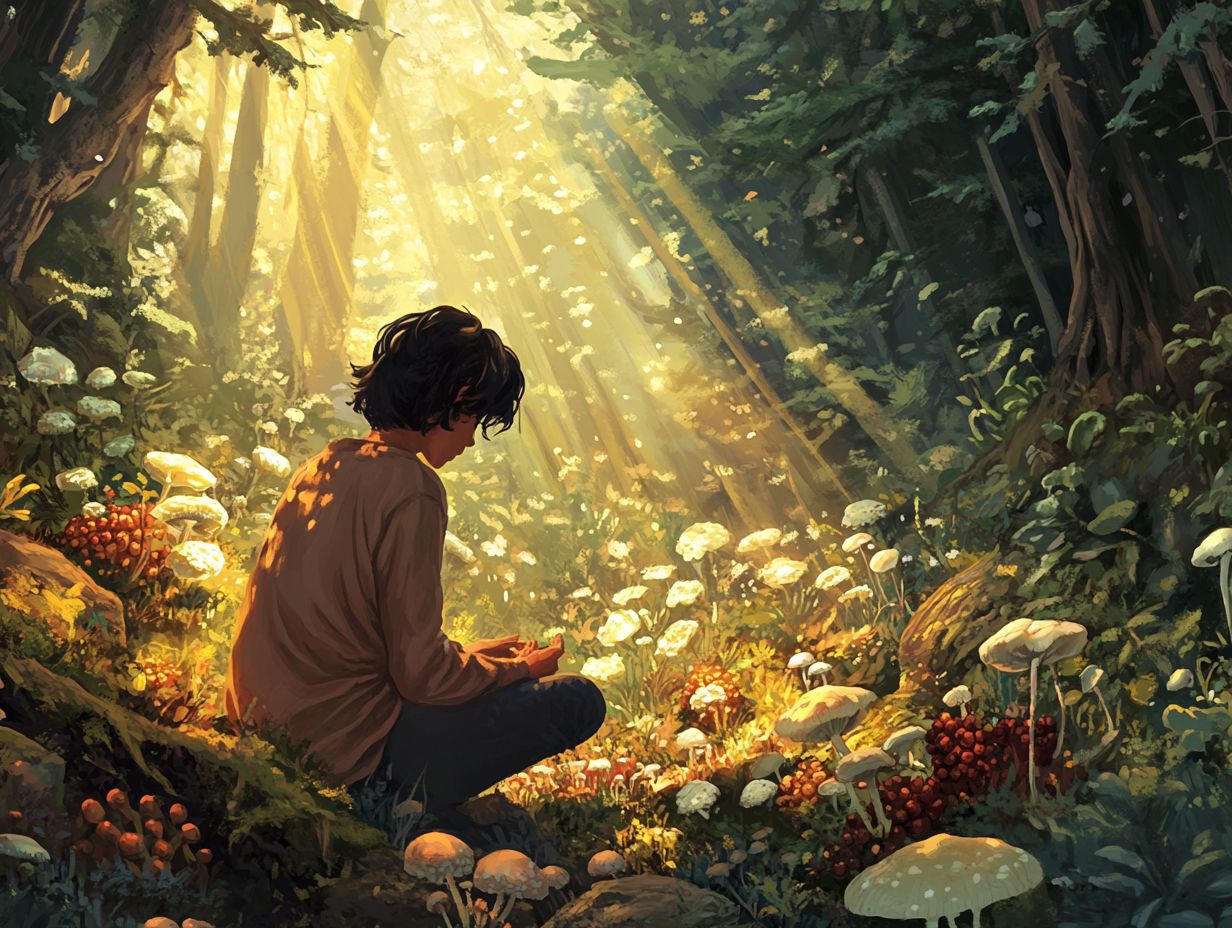
Preparing and cooking foraged foods can be rewarding. You can bring the freshest flavors of nature into your meals.
With many recipes and techniques at your fingertips, you can transform your wild food harvest into exquisite dishes that celebrate your local environment.
Embrace the artistry of foraging. Let each dish reflect the beauty of the natural world around you.
Recipes and Techniques
Creating meals from foraged ingredients can enhance your culinary experience. Showcase the unique flavors of wild food through various recipes and techniques.
By embracing foraging, you can uncover edible treasures in your local environment, from wild mushrooms and dandelion greens to berry bushes bursting with flavor. To learn more about this practice, check out how to use local resources for sustainable foraging. This journey not only enhances your appreciation for nature but also sparks creativity in your kitchen.
Imagine creating a refreshing salad adorned with finely chopped wild herbs or a rustic soup made with freshly foraged root vegetables. Each dish becomes a canvas for culinary exploration, inviting you to connect with the earth while nourishing your body.
Sustainable Foraging Practices
Sustainable foraging practices are vital for protecting our natural environment while enjoying the treasures that wild foods provide. By using ethical harvesting methods and respecting ecology, foragers like you can reduce your environmental footprint and build a positive relationship with nature.
How to Minimize Environmental Impact
Minimizing your environmental impact while foraging means using responsible harvesting methods and following guidelines that support the health of our environment.
One of the first steps is getting to know local regulations and the availability of species in your area. Ensure your gathering practices align with established guidelines. This includes understanding which plants are invasive and harmful to native ecosystems.
By prioritizing sustainable harvesting techniques like avoiding over-collection you can significantly reduce your footprint. Engage with local expert groups or attend workshops to deepen your knowledge and inspire a commitment to preserving natural habitats while enjoying nature’s treasures.
Frequently Asked Questions
What is foraging and why is it important to cultivate a love for it locally?

Foraging is gathering wild food resources from nature. It’s important to cultivate a love for foraging in your backyard because it supports sustainable living, connects us to our surroundings, and promotes a healthier diet.
How can I start foraging locally?
First, educate yourself about local edible plants and their seasons. Consider exploring resources like how to master foraging in your region or find a reputable foraging guide to learn how to identify and harvest wild foods properly.
Where are the best places to forage locally?
Public parks, forests, and nature reserves are excellent foraging spots, provided it s allowed and you have the necessary permits. You can even forage in your own garden or yard!
Is foraging legal?
In most places, foraging is legal. However, check local laws and regulations before harvesting wild foods.
Practice ethical foraging by only taking what you need. Leave enough for plants and animals to thrive!
What are the benefits of foraging locally?
Foraging provides access to fresh, healthy foods. It promotes physical activity, mental well-being, and a stronger connection to nature.
Plus, it can save you money on groceries and reduce your carbon footprint!
How can I incorporate foraged foods into my diet?
You can add foraged foods to salads, soups, stir-fries, or even desserts. Edible herbs like wild mustard and purslane can enhance your meals.
Remember to clean and cook foraged foods properly to avoid health risks.

